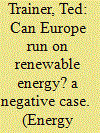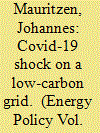|
|
|
Sort Order |
|
|
|
Items / Page
|
|
|
|
|
|
|
| Srl | Item |
| 1 |
ID:
126567


|
|
|
|
|
| Publication |
2013.
|
| Summary/Abstract |
The possibility of 100% renewable supply of European energy is analysed in terms of the amount of redundant plant required to cope with the intermittency of wind and solar energy, and the limited biomass potential. It is concluded that the capital cost would be unaffordable, and that biomass resources are insufficient.
|
|
|
|
|
|
|
|
|
|
|
|
|
|
|
|
| 2 |
ID:
150895


|
|
|
|
|
| Summary/Abstract |
Fossil fuels face resource depletion, supply security, and climate change problems; renewable energy (RE) may offer the best prospects for their long-term replacement. However, RE sources differ in many important ways from fossil fuels, particularly in that they are energy flows rather than stocks. The most important RE sources, wind and solar energy, are also intermittent, necessitating major energy storage as these sources increase their share of total energy supply. We show that estimates for the technical potential of RE vary by two orders of magnitude, and argue that values at the lower end of the range must be seriously considered, both because their energy return on energy invested falls, and environmental costs rise, with cumulative output. Finally, most future RE output will be electric, necessitating radical reconfiguration of existing grids to function with intermittent RE.
|
|
|
|
|
|
|
|
|
|
|
|
|
|
|
|
| 3 |
ID:
179681


|
|
|
|
|
| Summary/Abstract |
I investigate how the Covid-19 epidemic affected consumption and prices in a part of the Nordic electricity market that has a high penetration of intermittent renewable energy: Denmark and the southernmost part of Sweden. In sharp contrast to studies of other regions, I find no overall drop in consumption in this region. However, the distribution of consumption shifted away from peak hours. Nonetheless, prices dropped significantly, with a decline that started well before the imposition of societal restrictions in Denmark. Periods where wind power covered all of local load saw prices collapse towards zero with little variance under the Covid-19 epidemic. The results have important policy implications. Energy-only markets may fail to provide sufficient investment incentives for renewable energy when penetrations of such generation are already high. Policies and technologies that shift load from peak to non-peak times may further erode market incentives.
|
|
|
|
|
|
|
|
|
|
|
|
|
|
|
|
| 4 |
ID:
112330


|
|
|
|
|
| Publication |
2012.
|
| Summary/Abstract |
Jacobson and Delucchi have recently put forward a detailed case in support of the claim that renewable energy sources can meet total world energy demand. The following argument is that this proposal is unsatisfactory, primarily because it does not deal effectively with the problems set by the variability of renewable energy sources, and also because its analysis of investment costs is inadequate.
|
|
|
|
|
|
|
|
|
|
|
|
|
|
|
|
| 5 |
ID:
177319


|
|
|
|
|
| Summary/Abstract |
Resolving the resource adequacy problem has been usually entrusted to the imposition of some kind of long-term capacity requirements or to forward markets. The Operating Reserve Demand Curve (ORDC), which is linked to short-term market conditions and does not require central planning, has been presented as an alternative system with which to ensure long-term resource adequacy in the market. Using hourly data from the Texas ERCOT market between January 2015 and February 2019, we empirically show that ORDC prices are significantly negatively affected by wind generation. We find that, if wind generation is relatively low, a 1% increase in wind generation decreases the ORDC price by around 0.15–0.1%. This fact may preclude the ORDC from providing long-term price signals and price stability to generators. Moreover, we also find that if wind generation is greater than 9000 MW, the ORDC price is expected to be zero, which may further disincentive to increase generation capacity –especially dispatchable capacity that may be needed as a backup if the wind is not blowing.
|
|
|
|
|
|
|
|
|
|
|
|
|
|
|
|
| 6 |
ID:
166924


|
|
|
|
|
| Summary/Abstract |
Tapping into a large amount of renewable generation considering the inherent variability of renewable energy sources (RES) can greatly increase the risk of supply and demand imbalances in electric power delivery. One of the major components of this risk is the intermittency of both wind and solar power generation. In this paper, we show that by strategically planning for geographical and technological diversification of renewable generation capacity it is possible to reduce such risk in a RES-only US energy portfolio. We consider wind and solar as the sole sources of generation and use risk-averse stochastic optimization with Conditional Value-at-Risk (CVaR) to optimize energy generation locations and capacities in an idealized case study. The optimal RES portfolios demonstrate a significant improvement in generation profile compared to non-pooled or non-optimized alternatives. This confirms that with smart policy planning one can push the limits of the risk of imbalances in RES-only portfolios within continental United States, and highlights the need for system-wide thinking when designing a large-scale energy portfolio.
|
|
|
|
|
|
|
|
|
|
|
|
|
|
|
|
| 7 |
ID:
126482


|
|
|
|
|
| Publication |
2013.
|
| Summary/Abstract |
A method of quantifying operational CO2 savings from wind power generation is described with reference to the 2011 Irish electricity grid. Based on an emissions model and View the MathML source generation time-series for each grid connected thermal generator, it is estimated that wind power saved 0.28 tCO2/MWh on average, relative to an implied average carbon intensity in the absence of wind of 0.52 tCO2/MWh. These low savings are explained in terms of the response of individual thermal generators to intermittent wind generation.
|
|
|
|
|
|
|
|
|
|
|
|
|
|
|
|
| 8 |
ID:
162291


|
|
|
|
|
| Summary/Abstract |
An understanding of household demand response (DR) is important in view of increasingly smart grids in which high shares of renewable supply are being promoted. In addition, an important development in the Nordic market relates to increasing thrust on household solar photo-voltaic (PV) panels. In view of the potential for interaction between dynamic pricing-driven and PV generation-driven load changes, an analysis of the combined effects in relation to the system profile is important, not least because this can affect the nature of benefits to households and to the grid. Using a unique and detailed dataset on household electricity consumption, in combination with simulated solar panel micro-generation data, these aspects are explored here using a demand framework drawn from the previous literature. Our findings indicate that even with low price responsiveness, household response to dynamic pricing can lead to load changes with sizeable benefits. In addition, the introduction of PV panels appear to be beneficial to the electric grid, largely due to the time pattern of winter PV generation. Overall, our findings provide tentative support to the hypothesis that dynamic pricing, by incentivizing households to provide demand response at appropriate times, can aid in integration of renewables.
|
|
|
|
|
|
|
|
|
|
|
|
|
|
|
|
| 9 |
ID:
116711


|
|
|
|
|
| Publication |
2012.
|
| Summary/Abstract |
As electricity systems incorporate increasing levels of variable renewable generation, conventional plant will be required to operate more flexibly, with potential impacts for economic viability and reliability. Northern Ireland is pursuing an ambitious target of 40% of electricity to be supplied from renewable sources by 2020. The dominant source of this energy is anticipated to come from inherently variable wind power, one of the most mature renewable technologies. Conventional thermal generators will have a significant role to play in maintaining security of supply. However, running conventional generation more flexibly in order to cater for a wind led regime can reduce its efficiency, as well as shortening its lifespan and increasing O&M costs. This paper examines the impacts of variable operation on existing fossil fuel based generators, with a particular focus on Northern Ireland. Access to plant operators and industry experts has provided insight not currently evident in the energy literature. Characteristics of plant operation and the market framework are identified that present significant challenges in moving to the proposed levels of wind penetration. Opportunities for increasing flexible operation are proposed and future research needs identified.
|
|
|
|
|
|
|
|
|
|
|
|
|
|
|
|
| 10 |
ID:
166945


|
|
|
|
|
| Summary/Abstract |
The growth of intermittent renewable power generation has been drawing attention to the design of balancing markets. Portugal is an interesting case study because wind generation already accounts for a high fraction of demand (23% in 2012–2016), but still there are no economic incentives for efficient wind forecasting (wind balancing costs are passed to end consumers). We analyze the evolution of the balancing market from 2012 to 2016. Using actual market data, we find wind balancing costs around 2 euros per MWh of generated energy. One main reason for these low costs is the existence of a robust transmission grid, which allows for the compensation of positive with negative wind imbalances across the system. Nevertheless, the results suggest that final consumers could save several million euros per year if wind generators were made responsible for the economic cost of their imbalances, in line with other European markets.
|
|
|
|
|
|
|
|
|
|
|
|
|
|
|
|
| 11 |
ID:
096620


|
|
|
|
|
| Publication |
2010.
|
| Summary/Abstract |
Average market prices for intermittent generation technologies are lower than for conventional generation. This has a technical reason but can be exaggerated in the presence of market power. When there is much wind smaller amounts of conventional generation technologies are required, and prices are lower, while at times of little wind prices are higher. This effect reflects the value of different generation technologies to the system. But under conditions of market power, conventional generators with market power can further depress the prices if they have to buy back energy at times of large wind output and can increase prices if they have to sell additional power at times of little wind output. This greatly exaggerates the effect. Forward contracting does not reduce the effect. An important consequence is that allowing market power profit margins as a support mechanism for generation capacity investment is not a technologically neutral policy.
|
|
|
|
|
|
|
|
|
|
|
|
|
|
|
|
| 12 |
ID:
097462


|
|
|
|
|
| Publication |
2010.
|
| Summary/Abstract |
Average market prices for intermittent generation technologies are lower than for conventional generation. This has a technical reason but can be exaggerated in the presence of market power. When there is much wind smaller amounts of conventional generation technologies are required, and prices are lower, while at times of little wind prices are higher. This effect reflects the value of different generation technologies to the system. But under conditions of market power, conventional generators with market power can further depress the prices if they have to buy back energy at times of large wind output and can increase prices if they have to sell additional power at times of little wind output. This greatly exaggerates the effect. Forward contracting does not reduce the effect. An important consequence is that allowing market power profit margins as a support mechanism for generation capacity investment is not a technologically neutral policy.
|
|
|
|
|
|
|
|
|
|
|
|
|
|
|
|
|
|
|
|
|